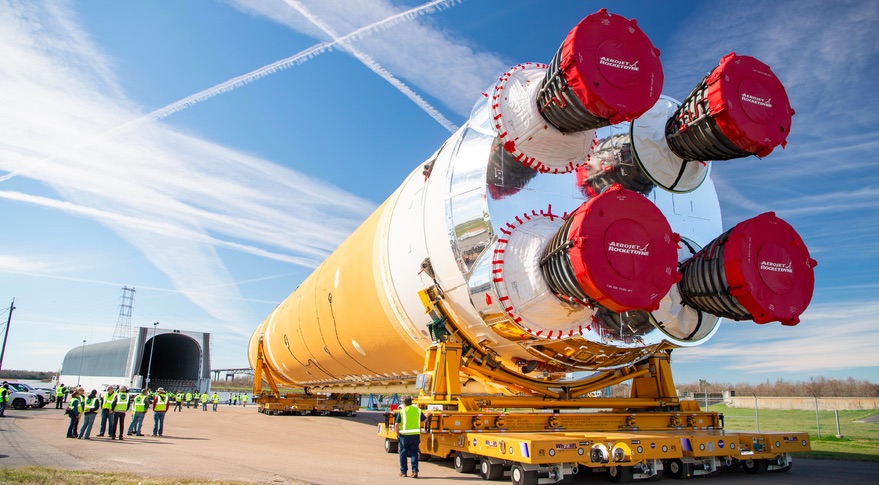
WASHINGTON — The cost of NASA’s Space Launch System has grown to the point where the agency must notify Congress and perform a formal reassessment of the program, NASA’s inspector general concluded in a March 10 report.
The report by the Office of Inspector General (OIG) found that the SLS program’s costs through the rocket’s first flight had grown by at least 33% from a formal agency baseline commitment, and likely will grow to at least 43% given projected delays in that launch.
That original commitment set the cost of SLS development through the first launch, Artemis 1, at $7 billion, a figure that does not include $2.7 billion in earlier formulation costs for the heavy-lift rocket. That commitment also missed costs associated with other aspects of the SLS program not directly tied to the Artemis 1 launch.
NASA has estimated the development costs through the Artemis 1 launch had grown to $8.75 billion, assuming a launch in November 2020, an increase of 25%. However, the OIG report noted that NASA had removed $889 million in costs for work on the vehicle’s solid rocket boosters and RS-25 engines, deeming them not directly tied to Artemis 1. NASA, though, did not rebaseline the program to that lower cost.
That had the effect, OIG concluded, of masking the actual cost growth of the program. It concluded that costs have grown by 33% through the end of fiscal year 2019 and 43% through the projected launch date.
This increase means that the SLS program passed the 30% cost increase threshold that requires a formal rebaselining of the program and notification of Congress. Moreover, NASA would have to stop funding the program 18 months after that notification unless Congress reauthorized the program and allocated funding to accommodate the cost increase.
Additional cost increases are likely for the Artemis 1 mission since the launch will slip from the November 2020 date used for those cost estimates. The OIG report states that NASA’s internal estimates project the launch taking place no earlier than the spring of 2021. In a Feb. 28 speech, Steve Jurczyk, NASA associate administrator, said he expected that launch to take place in the “mid to late ’21 timeframe.”
NASA is working on a new formal launch date for Artemis 1. In a response to the report, Doug Loverro, NASA associate administrator for human exploration and operations, and Tom Whitmeyer, acting deputy associate administrator for exploration systems development, said new launch dates for both Artemis 1 and Artemis 2 “are under review pending completion of several assessments,” which they projected to be done by the end of April.
“NASA leadership will review the results of these assessments and then rebaseline the SLS program,” they wrote. “NASA will communicate the results of these reviews to Congress and will comply with all the applicable reporting requirements.”
That assessment also does not capture the full cost of the SLS program, such as funds spent on work for Artemis 2 or later missions. The OIG report estimated that NASA will have spent $17 billion on SLS through the end of fiscal year 2020, of which $5.9 billion is not included in the baseline commitment.
NASA leadership, the report stated, acknowledged that approach “is not a good fit for managing a long-term human exploration program with multiple planned missions over decades,” but had decided to focus on costs through Artemis 1 early in the SLS program given uncertainty about long-term plans.
“While we understand the difficulty of setting baselines long into the future, total SLS Program cost increases will not be readily transparent because NASA is not tracking and reporting all costs against an official baseline,” the report stated. “For example, NASA currently does not have a cost estimate for Artemis II and is not tracking or reporting cost impacts caused by schedule delays or technical challenges for that mission.”
Much of the reason for the cost growth has been on the well-documented difficulties with the SLS core stage being built by Boeing. That included “repeated safety-related quality assurance nonconformances,” such as foreign object debris in core stage hardware, found in an October 2019 review by the Defense Contract Management Agency of Boeing’s work on the core stage at the Michoud Assembly Facility. That resulted in a two-day “production pause” there as Boeing developed a formal corrective action plan.
Boeing, in a March 10 statement, acknowledged the problems but argued that its performance will improve. “Such an undertaking has certainly had its cost and schedule challenges over the years, but the investment has paid off in bringing together the required talent, technology and tooling to build this unprecedented deep space rocket,” the company said. “The hard-earned experience acquired during initial SLS development is resulting in significant savings and efficiencies in subsequent development and production.”
The OIG report, though, noted problems with other aspects of the SLS. The cost of the rocket’s Interim Cryogenic Propulsion Stage, the upper stage of the Block 1 version of SLS, has more than doubled to $358 million through the Artemis 1 launch. Northrop Grumman, prime contract for the solid rocket boosters, has encountered problems with new material used as liner and insulation in the booster segments.
Aerojet Rocketdyne, which has a contract to produce new RS-25 engines when the current supply of shuttle-era engines is exhausted, has encountered a two-year delay developing the nozzle, although “task rearrangement” will delay final certification of that new engine by only three months. “The contractor’s spend rate currently meets expectations,” the OIG report stated, “but due to the schedule delays, cost overruns are likely to occur.”
https://news.google.com/__i/rss/rd/articles/CBMiSmh0dHBzOi8vc3BhY2VuZXdzLmNvbS9zbHMtY29zdC1ncm93dGgtZXhjZWVkcy10aHJlc2hvbGQtZm9yLWZvcm1hbC1yZXZpZXcv0gEA?oc=5
2020-03-11 11:00:51Z
52780657412621
Bagikan Berita Ini














0 Response to "SLS cost growth exceeds threshold for formal review - SpaceNews"
Post a Comment